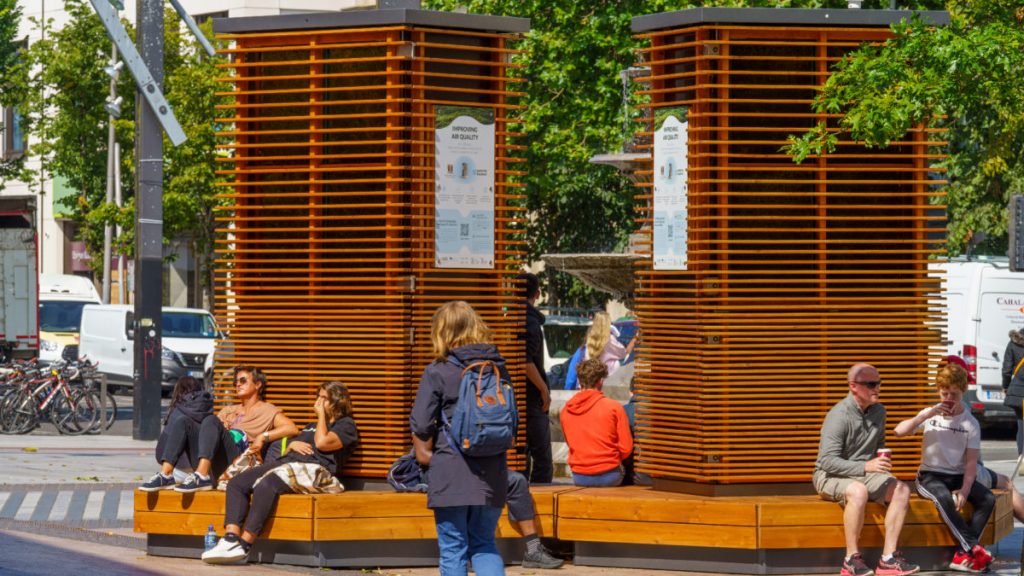“Moss is teeming with biota (mini plants and animals living in it) that we are pretty much unaware of, but which are an important part of the ecosystem.”
“Trees made of moss are starting to be created in cities, as it absorbs particles and pollutants. Moss also cools the environment.”
.
How much air pollution is there at Sidmouth’s busiest intersection? Much more than you would think: “Significant air pollution” in Sidmouth – update – Vision Group for Sidmouth
How about a ‘CityTree’ made up of moss to soak all of that up at the top of the High Street, then? CITYTREE – Green City Solutions As it does a fabulous job: Algae, lichens, and mosses take up huge amounts of carbon dioxide and nitrogen from atmosphere
Moss, in other words, is one of those ‘natural or ecosystem services’ which we take for granted: Benefits of natural services | Ecosystem services | Natural capital
And it has so many huge benefits for us – yes, in our own suburban gardens too: 7 interesting things about moss | Kew
Bunny Guinness writes in today’s Telegraph about this much overlooked and much derided plant:
On Gardeners’ Question Time at this time of year, we get many questions concerning moss – mainly as a problem in lawns. Recently, with wet winters, moss seems to be getting the upper hand. So, as many gardeners are dramatically changing their mindset when it comes to lawns, are we going to reappraise the benefits of moss, too? Should we really be purging our lawns of this emerald invader?
There are more than a thousand different species of moss in the UK, and according to my neighbour Jon Graham, who is an ecologist and notable moss expert, because of the range of types, you can find a species of moss to suit pretty much any conditions. When I asked Jon the best way to get rid of it, he was, not surprisingly, shocked. He pointed out that moss is teeming with biota (mini plants and animals living in it) that we are pretty much unaware of, but which are an important part of the ecosystem. It is a fantastic carbon sink too.
Apparently half a sq m of moss can absorb a kg of carbon dioxide: a staggeringly high amount, partly due to the surface area of moss being 30 times its size. “Trees” made of moss are starting to be created in cities, as it absorbs particles and pollutants, too. Moss also cools the environment, because its structure is like a sponge, sopping up moisture and then cooling the atmosphere as it evaporates. The founders of German-based company Green City Solutions, which has pioneered these “trees”, point out that in addition to binding CO2, moss filters numerous other gases and substances that harm the climate. One of these is soot (“black carbon”), which has an effect on global warming that is up to 1,500 times greater than that of CO2. Mosses filter such soot particles, which are present in the air as fine dust. They reckon a CityTree moss filter offsets up to 355kg of CO2 and CO2 equivalents per year, making it an effective climate-protection measure...

Maybe the sea change that is happening here in the UK with lawns – ie forgetting the spraying and fertilising regimes to allow monocultures of fine grasses, and relaxing our approach to allow a richer mix of broad leaves within the grass – should also start to encompass a new appreciation of moss, as we realise what a fabulous resource it is to encourage. King Charles uses the term “mown green spaces” for his lawns. He relishes the fact that they are teeming with carpeting thymes, selfheal, many other broadleaves and moss, and so they rarely go brown in the summer as a result…
Why all gardeners should learn to love moss | The Telegraph
Here is more on Green City Solutions: CITYTREE – Green City Solutions and Eureka | Green City Solutions refresh air pollution’s primeval enemy: moss
And here is Bunny Guinness with a helpful video:
Sterling Moss – Great Ways to Grow it, Use it or Loose it – YouTube